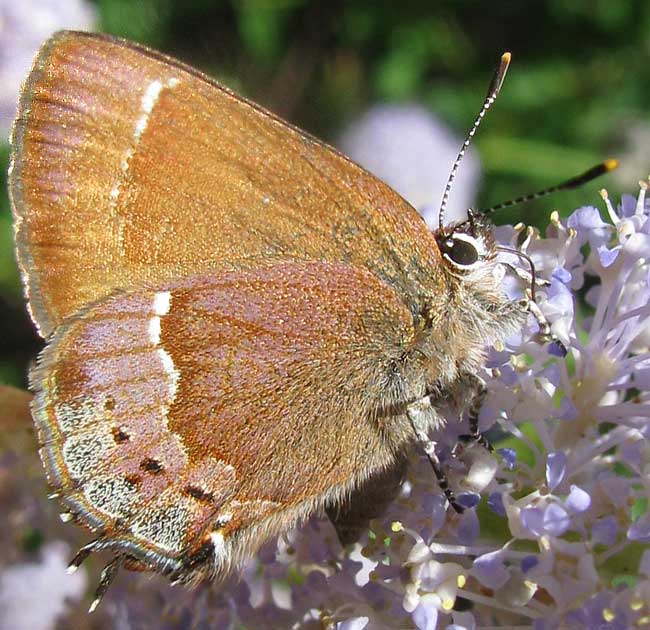Excerpts from Jim Conrad's
Naturalist Newsletter

from the June 7, 2009 Newsletter, issued from the Siskiyou Mountains west of Grants Pass, Oregon:
NELSON'S HAIRSTREAKS
This week the Deer Brushes flowered and they were just full of Nelson's Hairstreak butterflies, CALLOPHRYS NELSONI. You can see one sucking nectar through his slender, black, strawlike proboscis above.
Other Deer Brushes were similarly thick with Neslon's Hairstreaks. I'd not noticed the species before, so maybe their appearance is coordinated with the Deer Brushes' flowering.
There's a whole group of small, mostly tropical butterfly species known as hairstreaks distributed through several genera in the Gossamer-Wing Butterfly Family, the Lycaenidae, the Hairstreak Subfamily, the Theclinae. Hairstreaks bear slender little "tails" at the bottoms of their hind wings. In the above photo the black and white tails appear at different levels because as the butterfly probed for nectar its hind wings constantly moved up and down relative to one another, like someone warming his hands.
I doubt there was much actual rubbing involved, though, else the wings' delicate scales would come off. I'm guessing that the black-and-white moving tails look enough like the butterfly's head with probing antennae to cause some predators to attack the wrong end. In fact, I saw several hairstreaks with deep gashes in their rear hind wings.
That's not the only way hairstreaks may defend themselves. In the Nelson's Hairstreak's family, the Lycaenidae, the chrysalises of most species produce faint sounds by flexing their bodies and rubbing together the membranes between their body segments. It's supposed that this sound helps ward off parasites and small predators.
Another English name for the Nelson's Hairstreak is Incense Cedar Hairstreak, for this species lays its eggs on Incense Cedar, probably the most common tree in our forest here.
The species is distributed from British Columbia to Mexico's Baja California, east into Idaho and western Nevada.